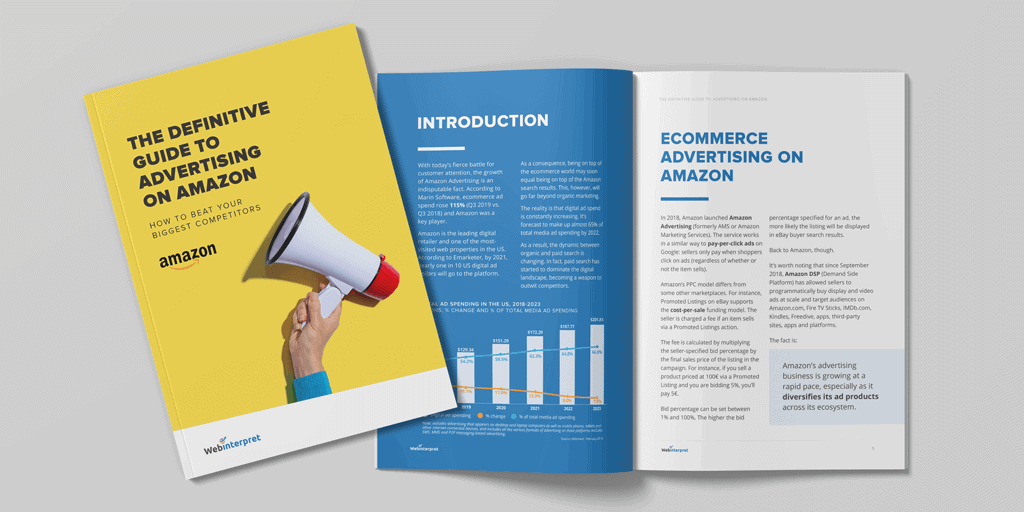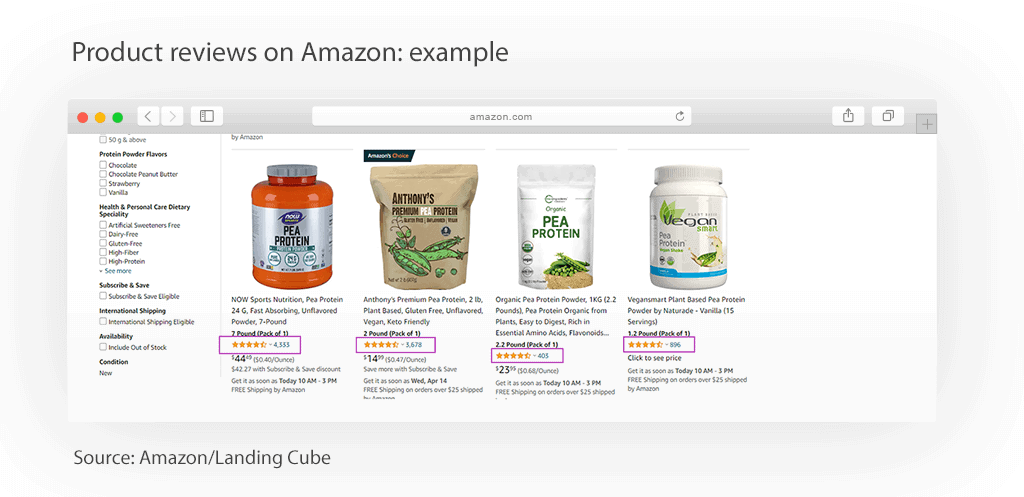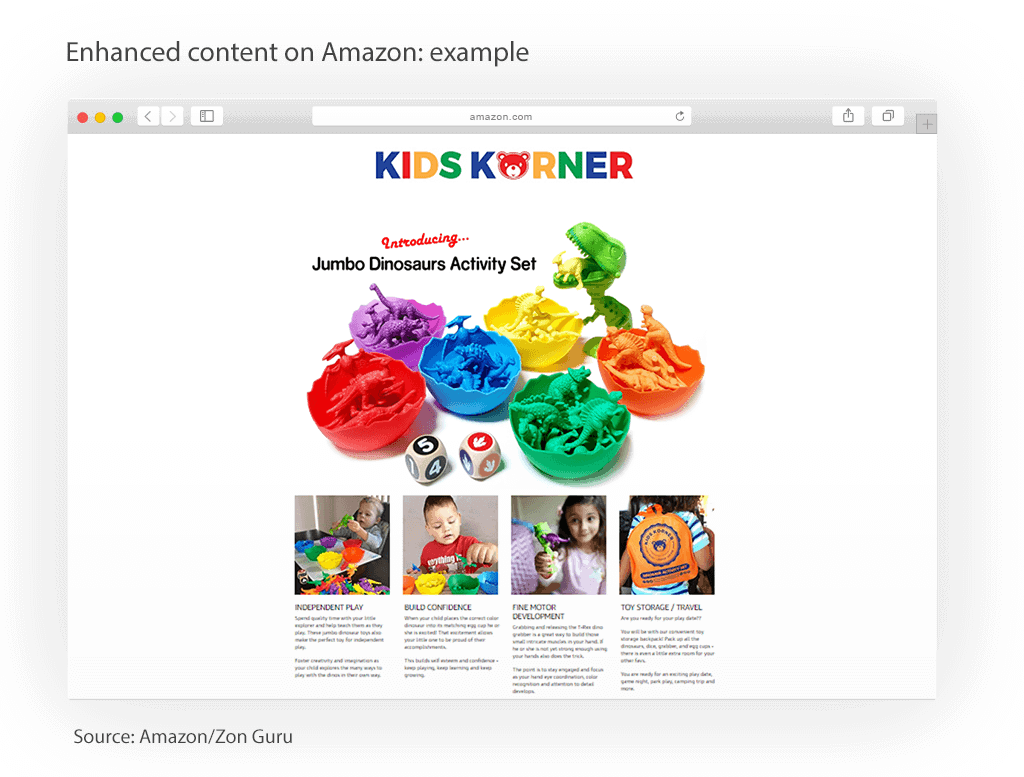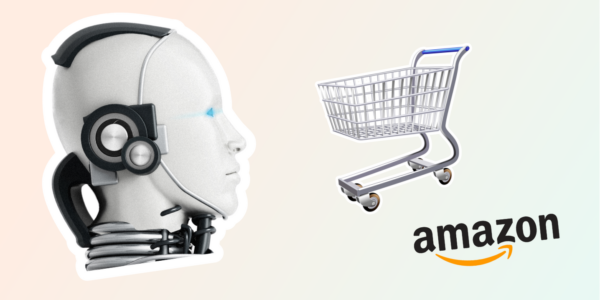
8 proven tips to increase sales on Amazon in 2022
How can you increase sales on Amazon in 2022?
Competition is huge. Only a well-thought-out action plan can help you beat your competitors and get more sales on Amazon.
However, it’s a game worth playing. 6 out of 10 product searches now start on Amazon. On Amazon. Not Google.
This comprehensive article contains carefully chosen recommendations. Learn about:
- Amazon SEO, search algorithm & keyword research
- 5 steps to Amazon product listing optimization (titles, product descriptions, bullets, images, backend keywords)
- Promoting & advertising your products on Amazon & other proven tips to grow your sales.
Click the links below to go directly to the topic of your interest:
#1 Amazon selling tip: understand the Amazon search algorithm
#2 Amazon selling tip: research keywords
#3 Amazon selling tip: optimize your Amazon product listings
#4 Amazon selling tip: drive external traffic to your Amazon listings
#5 Amazon selling tip: promote with Amazon Advertising
#6 Amazon selling tip: get customer reviews
#7 Amazon selling tip: sell on international Amazon market
#8 Amazon selling tip: win the Buy Box & other tips
Increase your sales with Amazon: factors contributing to online sales success
Amazon is the new shoppers’ search engine. Again: 6 out of 10 product searches now start on Amazon, not Google.
However, according to a 2019 study by Feedvisor, 45% of Amazon consumers don’t advance to the 2nd page of search results.
That’s why optimizing your Amazon product listings is essential to help you land and stay on the 1st page of search results.
7 factors that contribute to your online sales success on Amazon*:
- A good rating profile with positive buyer ratings
- Product information quality, e.g. comprehensive and accurate information, high-quality images
- Reasonable pricing
- Timely delivery
- Good visibility of your products on Amazon
- Promotion
- Knowledge of what sells best on Amazon.
* The information, data and guidance provided in this article is for general information purposes only and does not constitute professional advice.
Learn what sells best on Amazon
#1 Amazon selling tip: understand the Amazon search algorithm
To increase your Amazon sales, you need to understand the Amazon search engine.
A9/A10 is a maturing algorithm. As Amazon constantly makes changes to test what makes shoppers buy more, frequent and unpredictable updates can be frustrating for many sellers.
The A9 Amazon algorithm factors in:
- Keywords
- Impressions
- Internal sales, e.g. from “frequently bought with” items
- Organic sales
- Paid-per-click (PPC) sales
- Click-through rate (CTR)
- Conversion rate to sales
- Product price
- Product images and their quality
- Seller authority
- Sales history
- Customer reviews
- Off-site sales.
Amazon vs. Google
At its core, Amazon’s ranking algorithm is similar to Google’s search algorithm, e.g. they both rely on keywords for establishing relevance.
However, Amazon and Google users have different intentions. Google attracts mostly browsers and researchers in the discovery mode, Amazon attracts buyers in the shopping mode.
Thus, to decide the quality of a site, Google looks at loading speed, topical authority and user experience. Amazon looks at conversions and sales metrics.
Compared to Google, Amazon is a buying platform. We rarely go to Amazon for product research. We’re usually close to the point of purchase.
Amazon SEO & sales velocity
When it comes to Amazon SEO, an important metric is sales velocity: the number of items sold within a determined amount of time. Sales velocity reflects how fast a product sells.
The number of sales influences Amazon’s Best Sellers Rank (BSR) in a given category. BSR, which is updated hourly, helps you figure out how well a product performs. The better the BSR, the more sales it has accumulated.
It’s important to aim for a better sales velocity and BSR than your competitors, i.e. sell more units per hour.
Consider this example. When a new book is released, it’ll rise to the top of the best-seller list. Its ranking will fluctuate each hour, not day. The longer a book has been out, the more it’ll descend the bestseller list.
You can boost your sales velocity with external traffic, e.g. combine your PPC spend with traffic sent from outside Amazon.
The 3 essential things you need to optimize are visibility, relevance and conversions. In short, make shoppers see, click and buy your product.
To do this, you need to take care of a few important elements in your listings, such as listing title, product description, bullet points or images. More on that later.
AI Seller Tools for Amazon Sellers: FREE Download
#2 Amazon selling tip: research keywords
Your Amazon listings must have the search terms consumers look for on Amazon. Keywords appearing in your name can also improve your rankings.
Amazon uses a method of Artificial Intelligence called Natural Language Processing (NLP, branch of AI) to combine relevant words into popular phrases. So, if, let’s say, you have “sweater” in your title, “for women” in your bullets and “pullover” in your backend keywords: you will index for “pullover sweater for women”, but also for “pullover sweater” and “sweaters for women”.
To research Amazon keywords, consider using:
- Amazon Search Bar (type in the search term and see what suggestions or long-tail keywords come up)
- Keyword Tool for Amazon
- Keyword Inspector (an “Extensive Reverse ASIN” search on your top competitor)
- Helium 10 Scribbles Tool
- Jungle Scout
- Magnet
- Sellics.
Other sources of potential keywords include competitor pages, similar products section, data from Amazon PPC (which terms help listings convert) and popular keywords on Google.
In your seller’s dashboard (Reports → Advertising Reports → Search Term Report), you can access Amazon’s Automatic Campaigns tool to review your existing Amazon listings. You can also use a keyword report for additional research and search terms that your product already converts for.
#3 Amazon selling tip: optimize your Amazon product listings
In this section we’ll discuss how to optimize your Amazon product listings, including your product titles, descriptions, bullets, images and backend keywords.
Step 1: optimize your Amazon listing titles
Titles in your Amazon listings should include the product’s unique characteristics, benefits and your most relevant keywords. Amazon Seller Central uploaded Style Guides to help sellers structure their titles better.
Your Amazon product title:
- Must be 80-250 characters (Amazon recommends 80 characters for optimal display)
- Must use title case
- Must use words (avoid symbols)
- Should use numbers
- Does not use punctuation.
Titles typically have:
- In organic results between 115-144 characters depending on the product/category.
- In right rail ads around 30-33 characters
- In mobile listings between 55-63 characters.
Your title should contain the following elements (as per Amazon suggested best practices):
- Brand
- Product line
- Material or key feature
- Product type
- Color
- Size
- Packaging / quantity.
Each product type has a corresponding Amazon title formula. For instance, Amazon suggests the following templates for these popular product types:
- Kitchenware: Brand + Model Name + Model Number + Size + Product Type
- TV Sets: Brand + Model Name + Product Type + Color
- DVD Players: Brand + Model Name + Size + Product Type + Screen Type
- Jewelry: Brand + Product Category + Sex + Metal Variation + Shape + Material + Product Type
- Video Games: Brand + Product Type + Type of Platform.
Step 2: optimize your Amazon product descriptions
In your Amazon product description, tell buyers why they should finalize their purchase. Present a unique viewpoint on why people need the product and demonstrate how it will make their life better.
Write a concise, snappy description, including some key phrases you didn’t use in the title. However, remember to write your product description for sales rather than for the search algorithm.
If your title is your H1 text and bullet points H2, then you can think of your product description as H3. It may impact your ranking far less than your title and bullet points, but it’s important for conversions. So include a strong call-to-action, e.g. Buy Now, Order Today.
When it comes to formatting, Amazon allows for basic HTML to make your description easier to read. This includes bold, italics, quotes, line breaks and page breaks.
Your Amazon product description should:
- Have a character length of 2,000
- Be easily scannable
- Highlight the key product features and specs
- Include care instructions and warranty information as necessary
- Not include sale buzzwords like “free shipping” or “on sale now”
- Not include any company contact information or links to your websites.
Step 3: optimize your Amazon bullets
In Amazon bullets you can present the features and benefits of your product. For example, leather seats are a feature and the feeling of luxury is a benefit. Relevant keywords not used in the title can be worked into the bullets.
You have 5 bullet points. Use the first 3 bullet points to drive home your product’s most important features. Use the 4th and 5th bullets to answer common questions or overcome potential objections that might cause someone not to buy your product.
Bullets can influence your conversion rates and product relevance. It’s good to test the copy and order of the bullet points.
The guidelines for your Amazon product features (bullets) section:
- Keep each bullet to 200–250 characters
- Put your most important bullet at the top
- Focus on one benefit per bullet for better readability, e.g. e.g. Bullet 1: “Easy to use”, bullet 2: “High-quality”
- Be specific with features like size, dimensions, color
- Use all caps for the beginning of your bullets to emphasize key points
- Try to include many keyword variations in bullets, but keep it brief and readable
- You don’t have to use complete sentences
- Consider adding numbers
- Don’t use punctuation at the end of your bullet point
- Don’t mention sales, promotional pricing or shipping information
- Stay clear, concise, punchy and balanced.
In bullet points you can add long-tail keywords, related to different use cases (e.g. “Running shoes for _____”) or synonyms for your main keyword (e.g. “backpack/bag”).
Point out products your listing may be compatible with, e.g. if you sell phone cases, you may point out several brands and models they’re compatible with.
Step 4: optimize your Amazon images
Amazon requires that images be a minimum of 1,000 x 1,000 pixels. This way with its zoom feature, buyers can scroll over an image to enlarge it. Images that are 2,000 pixels x 2,000 pixels are recommended for added granularity.
The main image for your product should include only the product that you are selling (it should fill 85% of the space) against a white background.
Main images should not include:
- Accessories not included in the purchase
- Models or action shots of the image
- Text or badges such as “Made in the USA”.
Amazon will allow you between 5-9 images for your listing, depending on your product type and category. Your photos should be high-quality, high-resolution and taken from multiple angles.
To attract clicks, choose an eye-catching lead image for each Amazon listing. Then, depending on the product, show close-ups, lifestyle images, etc.
Examples of secondary images:
- Your product from different angles (side, top, close up)
- Your product in action
- The back of a product label
- A list of your product’s features
- Informational images with text/charts, etc.
- Showing your product’s size as compared to a human holding it.
Test your image placement to see which images elicit the highest conversion rate for your product. Test only one element at a time so you know which change impacted your listing, however positive or negative the impact
FREE Download: International Ecommerce Shipping
Step 5: optimize your Amazon backend keywords
Backend keywords on Amazon are “hidden” key terms you weren’t able to incorporate on the customer-facing side. For example, if you sell dog accessories, you can include the top 50 or 100 dog breeds as most owners may search “dog collar for Labrador”, etc.
Backend keywords get indexed just like the terms in your bullets and description. This is a good place to type any terms that will compete, long-tail searches, misspellings and words commonly used in your niche.
Your Amazon backend keywords need to meet the following guidelines:
- 50 character length per keyword
- Avoid punctuation where possible, except commas
- Be inclusive of misspellings and variations
- Include both singular and plural versions of important words, for example “dog” and “dogs”.’
- Don’t include brand names or product names
- Don’t repeat keywords or make sentences out of your keywords.
#4 Amazon selling tip: drive external traffic to your Amazon listings
Drive external traffic to boost your Amazon SEO. For example, instead of sending people directly to your product page, send them through a special keyword-optimized URL. The algorithm will give more ranking “juice” to this particular keyword.
Using keyword-optimized URLs will help you rank specific keywords faster. To target more keywords, you can send each subsequent customer to a separate page with a different keyword.
More examples of external traffic sources:
- An email list
- An external page with your Amazon product images, bullet points, product description and all relevant buying info
Facebook Ads to provide a spike in traffic - Google Ads to drive a steady increase of sales (and rankings) over time (once you start ranking).
Run the ads to a landing page where shoppers can redeem the offer and check out your product. They can also add their email addresses so you start building your list, by requiring an email opt-in to get the offer.
#5 Amazon selling tip: promote with Amazon Advertising
Imagine this. A buyer lands on your product detail page ready to purchase your product. Suddenly they see a competitor’s Sponsored Product ad. You lose the sale at the point of conversion due to your competitor’s cheaper price.
To minimize the occurrence of such situations, sponsor your own products. Try to “brand lock” your Amazon product detail page with your own alternative and complementary products.
Additionally, Amazon Advertising is the quickest way to boost your product listings or establish new ones. Without customer reviews or past sales, it can be difficult to rank organically on Amazon.
Amazon ads can boost individual listings to the top of search results pages, boost traffic to stores or show listings to interested customers that have navigated away from Amazon.
People browsing Amazon are usually ready to buy so your investment should pay off pretty quickly.
FREE Guide: Amazon Advertising
#6 Amazon selling tip: get customer reviews
A high number of customer reviews signals to Amazon that people enjoy your product and find it useful.
Thus, get honest and unbiased reviews as soon as possible. Honest reviews will tell you what your customers like and don’t like about your product so you can improve it.
To get customer reviews on Amazon, you can:
- Use the buyer-seller messaging service in seller central
- Use tools like Feedback Genius or Sales Backer to write custom email sequences to your buyers
- Ask social media followers to share their experiences.
A word of caution.
Amazon’s algorithm tries to verify the authenticity of reviews and prevent false reviews with sophisticated detection methods. Amazon banned incentivised reviews and created strict rules around customer communications. Brands can ask for reviews, but they cannot ask for positive reviews.
So be careful when requesting customer reviews. Using Amazon’s tool and its ‘Request a Review’ button allows you to ask for reviews in a way that complies with Amazon’s policies.
Further, with the Amazon Vine program, you can give products away for free in exchange for unbiased reviews from verified users.
#7 Amazon selling tip: sell on international Amazon markets
On Amazon you can sell on international markets with more sales potential and less competition than your domestic one.
The possibility of satisfying unmet demand abroad is one of the biggest worldwide opportunities for marketplace sellers.
According to eMarketer, 70% of online buyers already purchase from foreign sites. Furthermore, 80% of retailers worldwide agree that cross-border trade has been profitable or that sellers have successfully increased sales by as much as 1,000% after expanding their marketplace presence.
Amazon sellers who focus their sales and advertising efforts on their domestic markets limit their sales potential and options considerably. After all, Amazon has huge markets in many countries, for example in the USA, the UK or Germany.
Selling internationally helps sellers unlock their true sales success and mitigate risks when the unexpected occurs.
This is extra important when events, such as the coronavirus pandemic or Brexit, affect the global ecommerce market.
#8 Amazon selling tip: win the Buy Box & other tips
Winning the buy box on Amazon pays off: 82% of Amazon sales go through the buy box.
Typical buy box winners on Amazon:
- Price competitively
- Sell new items
- Are often Prime sellers
- Have consistently positive feedback
- Maintain consistent inventory levels.
7 extra selling tips to increase your Amazon sales:
#1. Maintain a consistent flow of sales over an extended period. It’s better to drive 30 sales a day for 7 days, than 100 sales in 1 day, completely stopping the next.
#2. Leverage Amazon’s tools (many are only available to members of Amazon’s Brand Registry), e.g. Amazon Analytics or A+ Content to enhance your product descriptions with cool layouts, images, graphics and videos.
#3. Earn special Amazon badges, such as Best Seller, Amazon’s Choice, New Release and Editorial Recommendations to improve your visibility in the search.
#4. Keep your inventory well-stocked at all times.
#5. Provide an exceptional customer experience.
#6. Set yourself apart from your competitors by communicating your USPs: what pain points does your brand address that your competitors don’t?
#7. Check reports and improve your performance metrics by going to Seller Central’s Detail Sales Page and Traffic.
Conclusion: how can you get more sales on Amazon?
Amazon is a competitive marketplace. However, with its multi-million active user base and unlimited sales opportunities, it beats other online selling platforms.
So who stands a good chance of success on Amazon?
Sellers with healthy performance metrics, plenty of reviews, good ratings and actively looking for opportunities on international Amazon markets.
About Webinterpret
Webinterpret enables Amazon and other marketplace sellers to sell more effectively in international markets through localized versions of their product listings. For more information, feel free to contact our cross border trade experts.

Here’s all you need to know about Amazon Advertising!
Sources
- a2x
- Master Amazon SEO
- How to Successfully Market Products on Amazon
- Tips and tricks to increase Amazon sales
- Rank Your Products on Amazon
- How to Rank on Amazon
- Amazon SEO: Ranking on Amazon
- Using Keywords for Better Amazon SEO
- Amazon's search algorithm
- Amazon's SEO Algorithm for Ecommerce
- Amazon SEO in 2022
- Amazon SEO: Get Your Products Found in 2022
- Amazon SEO in 2022
Related Posts:
Ecommerce Newsletter
By clicking the “Subscribe now” button, you agree to receive our monthly e-mail newsletter and regular marketing and commercial communications by email from Webinterpret regarding marketing trends and our digital marketing services. You confirm that you have read and agreed to Webinterpret’s Terms of Service and Privacy Policy.















